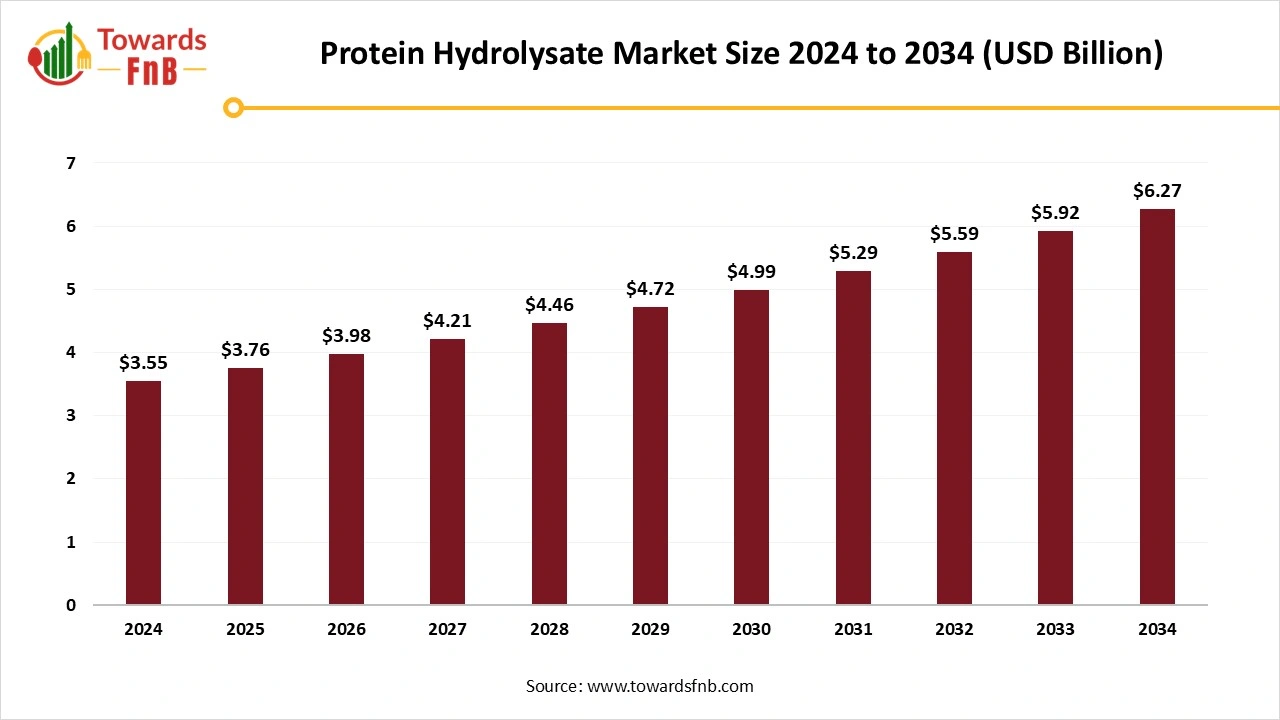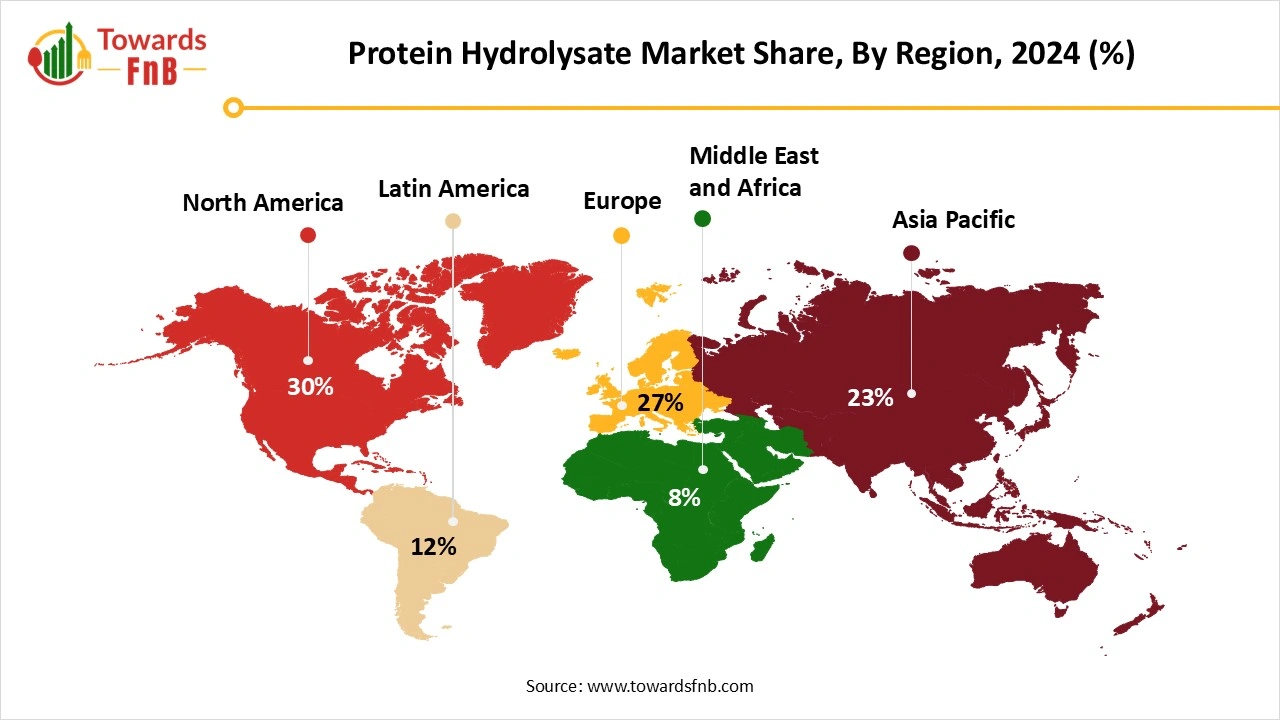November 2025
The global protein hydrolysate market size reached at USD 3.55 billion in 2024 and is anticipated to increase from USD 3.76 billion in 2025 to an estimated USD 6.27 billion by 2034, witnessing a CAGR of 5.85% during the forecast period from 2025 to 2034. Protein hydrolysate market is expanding significantly due to rising health awareness, demand for functional food and demand for protein-based food. Protein hydrolysate market is expanding significantly due to rising health awareness, demand for functional food and demand for protein-based food.

| Study Coverage | Details |
| Growth Rate from 2025 to 2034 | CAGR of 5.85% |
| Market Size in 2025 | USD 3.76 Billion |
| Market Size in 2026 | USD 3.98 Billion |
| Market Size by 2034 | USD 6.27 Billion |
| Largest Market | North America |
| Base Year | 2024 |
| Forecast Period | 2025 to 2034 |
| Regions Covered | North America, Europe, Asia-Pacific, Latin America, and Middle East & Africa |
Protein hydrolysates are derived by breaking down protein molecules into smaller peptides and amino acids through a process known as hydrolysis. This process enhances the digestibility and bioavailability of proteins, making them useful in a variety of applications such as food, beverages, animal feed, cosmetics, and pharmaceuticals. Protein hydrolysates are often used in formulations that require rapid absorption of protein or specific amino acids. The market for protein hydrolysates is growing due to the increasing demand for functional ingredients in health supplements, animal feed, and the rising popularity of plant-based proteins.
A significant opportunity for the protein hydrolysate market exists in the emerging economies throughout Latin America, Africa, and Eastern Europe. As affluence increases, food consumption habits are shifting, and health awareness is rising, consumers in these emerging markets are progressively investing in nutrient-dense functional foods and nutraceuticals. The youthful urban demographics in nations such as Brazil, India, Indonesia, and Nigeria represent a significant unexploited market for protein hydrolysate offerings.
A significant barrier is the elevated production costs, especially for premium protein hydrolysates that necessitate advanced technologies for extraction and hydrolysis. Moreover, obtaining raw materials like plant-derived proteins can be expensive, particularly when there are variations in their availability and pricing. The prices of key raw materials for producing protein hydrolysates, including milk, soy, and various protein sources, experience regular variations. These alterations in prices are affected by multiple elements, such as unforeseen weather patterns, supply chain issues, geopolitical conflicts, and shifts in farming regulations.
North America Dominated the Protein Hydrolysate Market in 2024.
In North America, the protein hydrolysates market is experiencing an increasing demand for clean label and natural ingredients, propelled by health-focused consumers looking for transparent and sustainable options. Moreover, there is an increasing interest in plant-derived protein hydrolysates, indicating shifting dietary trends and ethical concerns among consumers in the area.
The growing consciousness of health and wellness among consumers in the United States is fueling the need for nutritional supplements, where fish protein hydrolysate is highlighted for its excellent digestibility and essential amino acid availability. The popularity of protein rich food items is increasing as Americans grow more health-aware and pursue balanced diets that include adequate protein consumption. The USDA indicates that protein intake in the U.S. has risen by 2.5% each year over the last five years, highlighting the demand for ingredients rich in protein, like fish protein hydrolysate.

Asia Pacific Expects Significant Growth During the Forecast Period.
The growing populations in Asia Pacific nations such as India and China are leading to a higher demand for food and supplements, as well as an increase in protein deficiency cases among the regional populace, which is propelling the expansion of the Asia Pacific protein hydrolysate market. The growing number of people favoring vegetarian diets or vegan lifestyles is boosting the need for clean food alternatives and plant-based proteins, aiding in market growth. Food allergies and intolerances are becoming more common, leading to a higher demand for allergen-friendly food choices. Protein Hydrolysates provide a solution by being composed of smaller peptides, which lowers the likelihood of causing allergic reactions and renders them appropriate for those with particular dietary needs.
What Made the Animal-Based Protein Hydrolysate Segment Dominant in the Protein Hydrolysate Market in 2024?
Animal-based protein hydrolysate segment led the protein hydrolysate market in 2024. The increasing trend of protein-focused diets has led to a higher demand for animal protein in the food and beverage sector. The rising recognition of the health advantages of animal protein in meals drives their demand from consumers. The transition from synthetic protein mixtures to naturally sourced animal hydrolysates is significant for both luxury food and personal care brands.
Plant-Based Protein Hydrolysate Segment is Observed to Grow at the Fastest Rate During the Forecast Period.
This market growth is driven by a worldwide movement towards sustainability and environmentally-friendly practices, particularly in light of initiatives aimed at reducing the ecological footprint of food production. A notable trend is the rising demand for clean-label and minimally processed items, prompting manufacturers to create plant protein hydrolysates with reduced additives and preservatives. The FDA also indicated a 20% increase in consumer interest for plant-based protein items in 2023. The request for these hydrolysates is increasing because of greater recognition of their health benefits.
Which Application Segment Dominated the Protein Hydrolysate Market in 2024?
Food & beverages segment held the dominating share of the protein hydrolysate market in 2024, fueled by the increasing use of protein hydrolysates in items such as protein bars, ready-to-drink shakes, soups, and dairy drinks. The rise in consumer interest for high-protein, easily digestible, and functional food drives this growth, as hydrolysates improve nutritional value, texture, and solubility. Their minimal allergenic potential and quick absorption render them ideal for various consumer demographics, facilitating their application in both sweet and savory items. They are also utilized in baby formula, as their digestibility supports growing digestive systems.
Animal Feed Segment is Seen to Grow at a Notable Rate During the Predicted Timeframe.
The rising demand for premium, nutrient-dense animal feed, influenced by consumer choices for high-quality meat, dairy, and seafood, is a major factor propelling the protein hydrolysates market, fueled by a growing need for highly bioavailable protein options in livestock nutrition. Increased worries regarding animal health, feed efficiency, and disease resistance have spurred the adoption of functional feed additives like protein hydrolysate. Moreover, the accessibility of affordable plant and fish-based raw materials and the growing use of hydrolysates in starter and specialty feeds are promoting sustained market growth.
Which Form of the Protein Hydrolysate Dominated the Protein Hydrolysate Market in 2024?
Powder protein hydrolysate segment dominated the market with the largest share in 2024. This format is favored in dietary supplements, medical nutrition, and food applications due to its extended shelf life, precise dosing, and convenient transport. Powders dissolve readily in liquids, making them ideal for instant beverages, protein shakes, and flavoring applications. Moreover, they offer a substantial protein content per serving, increasing their attractiveness in clinical nutrition and performance items. Producers gain from reduced logistics expenses and expanded distribution abilities.
Liquid Protein Hydrolysate Segment is Expected to Grow at the Fastest Rate in the Market During the Forecast Period.
Due to their swift absorption and convenience of use in medical and sports nutrition. Their liquid state is particularly preferred in products such as energy drinks and enteral feeding solutions, where rapid nutrient absorption is crucial. Liquid protein hydrolysates are easily added to different drinks and formulations, providing convenience for consumers and producers alike. This user-friendliness aids in their extensive use in sports nutrition and medical environments.
Why did the Enzymatic Hydrolysis Segment Dominated the Protein Hydrolysate Market in 2024?
Enzymatic hydrolysis segment held the largest share of the market in 2024. Its effectiveness is credited to the regulated and efficient degradation of proteins into peptides and amino acids without producing undesirable byproducts. The method is acclaimed for maintaining the nutritional quality of the end product, leading to improved absorption and taste. The increasing demand for natural, functional components in pet food and animal feed reinforces enzymatic hydrolysis as the favored technique in this sector.
Alkaline Hydrolysis Segment is Observed to Grow at the Fastest Rate During the Forecast Period.
Attributed to its affordability, simplicity in scaling production, and versatility for different applications. It provides specific benefits compared to other techniques such as enzymatic or acid hydrolysis regarding temperature and time demands. Improvements in technology and process efficiency have simplified and reduced the costs of scaling alkaline hydrolysis processes. This enables higher production levels to satisfy the rising demand from various sectors.
Which Distribution Channel Dominated the Protein Hydrolysate Market in 2024?
Direct sales segment led the market in 2024. Direct sales foster a robust connection with key customers, allowing for tailored solutions to their needs while ensuring consistent quality and availability of your products. Especially for bulk purchasers like food and drink producers, nutraceutical businesses, and pharmaceutical firms. This would serve as a resource for any purchasers seeking bulk orders or extended supply agreements.
Online Retail Segment is Seen to Grow at a Notable Rate During the Predicted Timeframe.
The convenience and ease of access provided by online shopping significantly influence consumers, enabling them to buy hydrolyzed wheat protein products from the comfort of their own homes. E-commerce sites offer multiple choices, comprehensive product descriptions, user feedback, and ratings, aiding shoppers in making knowledgeable choices. Digital marketing and social media ads successfully connect with a larger audience, enhancing online sales. Unique online deals, special offers, and membership services additionally encourage shoppers to purchase hydrolyzed wheat protein items via the internet.
Raw Material Procurement
Processing and Preservation
Quality Testing and Certification
Packaging and Branding

By Source
By Application
By Form
By Processing Type
By Distribution Channel
By Region
The global carbonated beverages market size is expected to register at a CAGR of 6.5%, growing from USD 654.98 million in 2025 to USD 1,154.44 million...
The global AI in coffee production market size is forecasted to expand from USD 324.88 million in 2025 to USD 1,474.28 million by 2034, growing at a C...
The global white mushroom market size is projected to expand from USD 44.65 billion in 2025 to USD 74.16 billion by 2034, growing at a CAGR of 5.8% du...
November 2025
November 2025
November 2025
November 2025